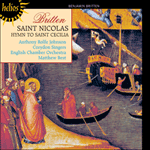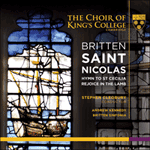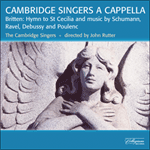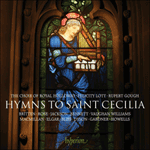
Welcome to Hyperion Records, a British classical label devoted to presenting high-quality recordings of music of all styles and from all periods from the twelfth century to the twenty-first.
Hyperion offers both CDs, and downloads in a number of formats. The site is also available in several languages.
Please use the dropdown buttons to set your preferred options, or use the checkbox to accept the defaults.

| Royal Holloway Choir, Rupert Gough (conductor), Sophie Edwards (soprano), Samantha Cobb (soprano), Leilani Barratt (alto), James Gallimore (tenor), Amon-Ra Twilley (bass)» More |
| Corydon Singers, Matthew Best (conductor)» More |
| The Cambridge Singers, Sir John Rutter (conductor), Caroline Ashton (soprano), Donna Deam (soprano), Susanna Spicer (alto), Angus Smith (tenor), Charles Pott (bass)» More |
| Adam Banwell (treble), William Hirtzel (treble), Andreas Eccles-Williams (treble), Ruairi Bowen (tenor), Daniel D'Souza (bass), King's College Choir Cambridge, Sir Stephen Cleobury (conductor)» More |
 PERFORMANCE
PERFORMANCE RECORDING
RECORDINGThe departure from America coincided with Britten’s final severance from Auden’s influence, but just before he left he began work on a setting of Auden’s three poems ‘A Song to St Cecilia’. These were dedicated to him (Britten’s birthday fell on St Cecilia’s Day, 22 November), but he found himself unable to complete the work. The voyage, however, proved therapeutic; his creative imagination began to work again and the Hymn to St Cecilia was finished, as the score proclaims, ‘at sea’. So was A Ceremony of Carols. In a sense these two works represent an end and a new beginning. The Auden setting signifies the end of the appeal of tricksy rhyming, and puts a final closure to the charges of false sophistication and glib facility that had sometimes been levelled at Britten’s early work. The medieval carols on the other hand signal the return to something fundamentally English, deep rooted, familiar, and conservative in the best sense.
The Hymn to St Cecilia is set for five-part unaccompanied chorus. The three poems, ‘In a garden shady’, ‘I cannot grow’, and ‘O ear whose creatures cannot wish to fall’ are linked by the litany
Blessed Cecilia, appear in visions
To all musicians, appear and inspire:
Translated Daughter, come down and startle
Composing mortals with immortal fire.
At certain junctures in his final poem Auden, like Dryden before him, refers to specific instruments—violin, flute, drum and trumpet—but Britten, having no orchestra, studiously avoids any temptation to imitate, inserting instead short isolated solo cadenzas which serve the dual purpose of suggesting an instrumental source while, more importantly, directing the listener’s attention to some of Auden’s most powerfully emotive lines. A repeat of the ‘Blessed Cecilia’ quatrain brings this concentrated and imaginative work to a close.
from notes by Kenneth Dommett © 1988
Britten quitta l’Amérique en même temps qu’il rompit pour de bon avec l’influence d’Auden, dont il entreprit cependant de mettre en musique, juste avant de partir, les trois poèmes «A Song to Saint Cecilia», qui lui était dédiés (il était né le 22 novembre, jour de la Sainte-Cécile). Mais il ne parvint pas à l’achever. La traversée s’avéra, néanmoins, thérapeutique: son imagination créative se remit en marche et l’Hymn to Saint Cecilia fut achevée, comme le déclare la partition, «en mer»—à l’instar d’A Ceremony of Carols. Ces deux œuvres incarnent, en un sens, une fin et un nouveau commencement. La mise en musique des textes de Auden marque ainsi la fin de l’attrait pour les rimes épineuses tout en mettant un terme aux accusations de fausse sophistication et de trop grande facilité dont avaient parfois été accablées les premières œuvres de Britten. Quant aux carols médiévaux, ils marquent le retour à quelque chose de foncièrement anglais, de profondément enraciné, de familier et de conservateur, au meilleur sens du terme.
L’Hymn to Saint Cecilia est écrite pour un chœur a cappella à cinq parties. Les trois poèmes («In a garden shady», «I cannot grow» et «O ear whose creatures cannot wish to fall») sont reliés par la litanie:
Bienheureuse Cécile, apparais en vision
À tous les musiciens, apparais et inspire-les;
Fille transférée au ciel, descend et stupéfie
Les mortels compositeurs d’un feu immortel.
À certains moments de son dernier poème, Auden, comme Dryden avant lui, fait référence à des instruments spécifiques—violon, flûte, timbale et trompette—, mais Britten, qui ne dispose pas d’orchestre, évite soigneusement toute tentative d’imitation, préférant insérer de courtes cadenzas solo isolées, à la fonction double: suggérer une source instrumentale et, parallèlement, ce qui est le plus important, faire porter l’attention de l’auditeur sur les vers d’Auden les plus chargés d’émotion. Une reprise du quatrain «Blessed Cecilia» parachève cette œuvre intense et inventive.
extrait des notes rédigées par Kenneth Dommett © 1988
Français: Hypérion
Die Abreise aus Amerika fiel mit Brittens endgültiger Abnabelung von Audens Einfluss zusammen, aber kurz bevor er ging, begann er an einer Vertonung von Audens drei Gedichten „A Song to St Cecilia“ („Ein Lied an die Heilige Cäcilia“). Diese waren ihm gewidmet (Brittens Geburtstag fiel auf den Cäcilientag am 22, November), aber er fand, dass er das Werk nicht fertigstellen konnte. Die Reise erwies sich jedoch als therapeutisch, seine kreative Erfindungskraft begann wieder zu funktionieren und die Hymn to St Cecilia (wie auch A Ceremony of Carols) wurde, wie die Partitur verkündet, „auf See“ vollendet. In gewissem Sinne verkörpern diese beiden Werke einen Abschluss und Neuanfang. Die Auden-Vertonung repräsentiert das Ende der Begeisterung für trickreiche Reime und macht der falschen Kultiviertheit und aalglatten Gewandtheit ein Ende, die Brittens frühen Werken oft vorgeworfen wird. Die mittelalterlichen Weihnachtslieder andererseits signalisieren die Rückkehr zu etwas fundamental Englischem, tief Verwurzelten, Vertrauten und im besten Sinne des Wortes Konservativem.
Die Hymn to St Cecilia („Cäcilienhymne“) ist für fünfstimmigen Chor a cappella gesetzt. Die drei Gedichte „In a garden shady“, „I cannot grow“ und „O ear whose creatures cannot wish to fall“ werden durch folgende Litanei verknüpft:
Heilige Cäcilia, erscheine in Visionen
Allen Musikern, erscheine und beflügle sie;
entrückte Tochter, komm herab und fache
komponierende Sterbliche mit unsterblichem Feuer an.
An gewissen Stellen in diesem letzten Gedicht erwähnt Auden, wie Dryden vor ihm, bestimmte Instrumente—Violine, Flöte, Pauken und Trompeten—aber Britten, der kein Orchester hatte, widerstand sorgfältig aller Versuchung, sie nachzuahmen, und fügt stattdessen kurze, isolierte Solokadenzen ein, die eine doppelte Funktion erfüllen: sie deuten eine Instrumentalquelle an, wenden aber besonders die Aufmerksamkeit des Hörers auf Audens gefühlsgeladenste Zeilen. Eine Wiederholung des Vierzeilers „Blessed Cecilia“ bringt dieses konzentrierte und einfallsreiche Werk zum Abschluss.
aus dem Begleittext von Kenneth Dommett © 1988
Deutsch: Renate Wendel
 Britten: Saint Nicolas & Hymn to Saint Cecilia Britten: Saint Nicolas & Hymn to Saint Cecilia‘A very fine recording’ (Gramophone) ‘A fresh and atmospheric account of Britten's colourful cantata’ (The Penguin Guide to Compact Discs)» More |
 Britten: Saint Nicolas & other choral works Britten: Saint Nicolas & other choral worksA new recording of Britten's enchanting choral masterpiece 'Saint Nicolas' celebrates 100 years since the composer's birth.» More |
 Cambridge Singers A Cappella Cambridge Singers A CappellaThis album explores the great wealth of music written for unaccompanied choir in England, France and Germany during the Romantic era and into the twentieth century.» More |
 Hymns to Saint Cecilia Hymns to Saint CeciliaA new choral compendium from the highly regarded Choir of Royal Holloway, comprising twentieth- and twenty-first-century works written in honour of Saint Cecilia, the patron saint of music.» More |

